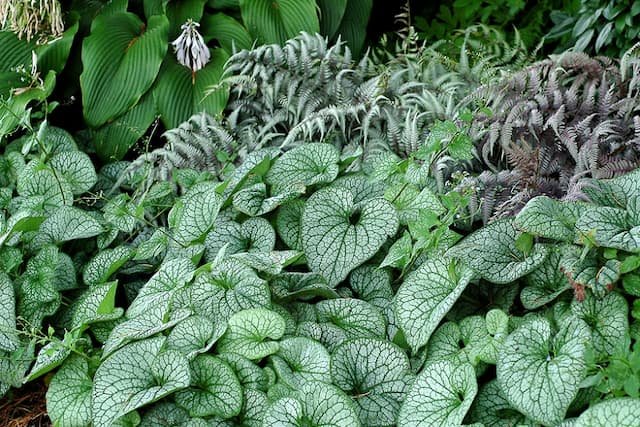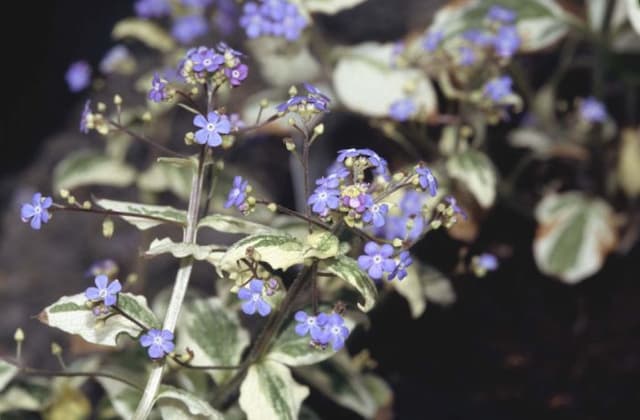Comfrey Symphytum grandiflorum

ABOUT
Symphytum grandiflorum, commonly known as creeping comfrey, is an herbaceous perennial that boasts an attractive appearance. This plant has a basal arrangement of leaves that are rough in texture, and they typically have an elongated, ovate shape. These leaves form a dense foliage that spreads across the ground, providing a lush, green backdrop. The flowers of creeping comfrey are what make this plant particularly appealing. They emerge in clusters and exhibit a bell-like form, which provides a charming and delicate look. The color of the flowers ranges from creamy yellow to soft ivory, and they possess a subtle, gentle grace that can attract various pollinators to the garden. Creeping comfrey's foliage may extend outward with a sprawling habit, creating a ground cover that can thrive in a variety of garden settings. Its leaves maintain their vibrant green hue throughout the season, while the flowers are generally in bloom during the spring months, adding seasonal interest to the plant's profile. The overall appearance of creeping comfrey is one of understated elegance, with its combination of expansive leaves and elegant flowers contributing to a serene and inviting garden aesthetic.
About this plant
 Names
NamesSynonyms
Creeping Comfrey, Large-Flowered Comfrey, Ornamental Comfrey, Ground Cover Comfrey, Dwarf Comfrey.
Common names
Symphytum grandiflorum.
 Toxicity
ToxicityTo humans
Comfrey, which is the most common name for Symphytum grandiflorum, contains compounds that can be toxic to humans if ingested. These compounds are primarily pyrrolizidine alkaloids, which can cause liver damage and have the potential to be carcinogenic. The symptoms of poisoning from ingesting comfrey may include abdominal pain, nausea, vomiting, liver damage, and in severe cases, it may result in hepatic failure. It is particularly dangerous to consume comfrey in large amounts or over a prolonged period. The external use of comfrey on the skin is generally considered safe, but internal use should be avoided.
To pets
Comfrey is also toxic to pets due to the presence of pyrrolizidine alkaloids. If a pet ingests this plant, the animal may experience symptoms similar to those in humans, including gastrointestinal upset, such as vomiting and diarrhea, as well as potential liver damage if consumed in large quantities or over an extended period. Chronic ingestion can lead to severe and potentially fatal liver failure. It is crucial to prevent pets from ingesting comfrey and to seek veterinary help if poisoning is suspected.
 Characteristics
CharacteristicsLife cycle
Perennials
Foliage type
Deciduous
Color of leaves
Green
Flower color
Yellow
Height
1-2 feet (30-60 cm)
Spread
1-2 feet (30-60 cm)
Plant type
Herb
Hardiness zones
4
Native area
Caucasus
Benefits
 General Benefits
General Benefits- Ornamental value: Symphytum grandiflorum, commonly known as comfrey, offers aesthetic appeal to gardens with its large, bell-shaped flowers and lush foliage.
- Soil improvement: Comfrey has deep roots that help to break up heavy soils and improve soil structure, promoting better water infiltration and aeration.
- Attracts pollinators: The flowers of comfrey are a food source for bees and other pollinators, supporting biodiversity in the garden.
- Companion planting: Comfrey can be beneficial when planted alongside other crops, as it can provide nutrients when its leaves decompose and act as a natural mulch.
- Wildlife habitat: The dense foliage of comfrey provides shelter for beneficial insects and small animals, thus enhancing the ecological balance of the garden environment.
 Medical Properties
Medical PropertiesThis plant is not used for medical purposes.
 Air-purifying Qualities
Air-purifying QualitiesThis plant is not specifically known for air purifying qualities.
 Other Uses
Other Uses- Symphytum grandiflorum, commonly known as comfrey, can be used as a green mulch or cover crop. Its rapid growth helps suppress weeds and adds nutrients to the soil when it breaks down.
- Comfrey is useful as a companion plant in the garden, attracting pollinators and beneficial insects essential for biological pest control.
- The leaves of comfrey can be added to a compost heap as an activator; they decompose quickly and can help speed up the composting process.
- Comfrey's deep roots have the ability to mine nutrients from deep within the soil, which can be accessed when the leaves are used as a mulch or in compost, effectively recycling nutrients back to the surface.
- Plant residues of comfrey can be used to create a natural liquid fertilizer through a fermentation process, which is then diluted and used to feed other plants.
- The fibers extracted from comfrey have been traditionally used in papermaking, adding a unique texture and strength to the finished product.
- Due to its natural mucilage, comfrey leaves can be used as a natural plant-based thickener in food recipes, though it is not commonly used for this purpose.
- Comfrey can be used as an organic animal fodder, particularly for chickens and pigs, because of its high protein content. Caution is needed, however, as it also contains compounds that can be toxic to animals if consumed in large quantities.
- When planted along riverbanks or slopes, comfrey can help reduce soil erosion with its deep root system, acting as a stabilizing agent.
- Some gardeners create decorative borders and low hedges with comfrey because of its attractive flowers and large leaves, adding structure to garden beds.
Interesting Facts
 Feng Shui
Feng ShuiThe Comfrey is not used in Feng Shui practice.
 Zodiac Sign Compitability
Zodiac Sign CompitabilityThe Comfrey is not used in astrology practice.
 Plant Symbolism
Plant Symbolism- Healing: Symphytum grandiflorum, commonly known as comfrey, has been historically used for its medicinal properties, especially in helping to heal wounds, broken bones, and sprains due to its compound allantoin, which is known to aid in cell growth and repair.
- Protection: Folk traditions often include comfrey in rituals and amulets to provide protection, particularly to travelers and to safeguard against theft.
- Money: In some folklore, comfrey is believed to bring about financial gain or prevent monetary loss, when the leaves are placed in one's wallet or purse.
- Safety during travel: With its supposed protective qualities, carrying comfrey was also believed to ensure safety during travel, protecting the traveler from accidents and hazards.
 Water
WaterComfrey, which is another name for Symphytum grandiflorum, should be watered deeply about once a week, making sure that the soil is fully saturated. During hot or dry spells, it might need water twice a week. Generally speaking, each watering session should involve about 1 to 1.5 gallons of water, depending on the size and maturity of the plant, as well as the soil composition. Over-watering should be avoided as this can lead to root rot. It's essential that the plant is in well-draining soil to prevent excess moisture build-up.
 Light
LightComfrey thrives best in full sun to partial shade conditions. An ideal spot for this plant is an area where it can receive direct sunlight for at least four to six hours a day, followed by dappled or indirect light. Placing comfrey in deep shade might inhibit its growth and blooming capability.
 Temperature
TemperatureComfrey is quite cold-hardy and can withstand temperatures as low as -30°F, making it suitable for many temperate gardens. It thrives in temperatures between 50°F and 75°F, which are ideal for its growth. It can survive the heat of up to 85°F, but it's important to ensure adequate water during these hot periods.
 Pruning
PruningPruning comfrey, also known as ‘Knitbone’ or ‘Healing Herb’, is mainly done to remove old, damaged, or dead leaves and to control its size. Prune back the foliage in late autumn or early winter to keep the plant tidy. Pruning can also stimulate new growth in the spring. It is not necessary to prune frequently, once a year is usually sufficient.
 Cleaning
CleaningAs needed
 Soil
SoilComfrey prefers a rich, well-draining soil mix with a pH between 6.0 and 7.0. For the best soil mix, combine garden soil, compost, and perlite or sand to ensure adequate drainage and fertility.
 Repotting
RepottingComfrey, or Symphytum grandiflorum, typically doesn't need frequent repotting and can be repotted every 2-3 years or when it has outgrown its current container.
 Humidity & Misting
Humidity & MistingComfrey thrives in average humidity conditions and does not require any special humidity adjustments for optimal growth.
 Suitable locations
Suitable locationsIndoor
Place Comfrey in bright, indirect light with ample space.
Outdoor
Plant Comfrey in partial shade, in moist, well-drained soil.
Hardiness zone
3-9 USDA
 Life cycle
Life cycleComfrey (Symphytum grandiflorum) begins its life cycle when seeds are sown in the soil, typically in spring or early summer. Once germinated, the seedlings develop into a rosette of hairy, lance-shaped leaves. As the plant matures, it forms a deep taproot and begins to grow erect flowering stems. Flowers appear on comfrey typically from late spring to early summer; they are bell-shaped, usually cream or yellow, and are pollinated by bees. After pollination, the flowers develop into small, four-lobed nutlets that contain the seeds for the next generation. Comfrey is a perennial, so after flowering, the above-ground plant parts die back, but the taproot survives through winter and regenerates the following spring.
 Propogation
PropogationPropogation time
Spring to early summer
Symphytum grandiflorum, commonly known as creeping comfrey, is a plant which is most effectively propagated through division due to its clumping growth habit. Division should be done in early spring or fall when the plant is not in active growth. To propagate by division, carefully dig up an established clump of creeping comfrey and gently separate the crown into smaller sections, each with its own roots and shoots. These sections should then be immediately replanted into well-prepared soil, with the crown set at the same depth it was growing at previously. Water the new plantings thoroughly to help establish them. The divisions will typically start to grow quickly, establishing themselves as independent plants. This method is favored for its simplicity and high success rate.









